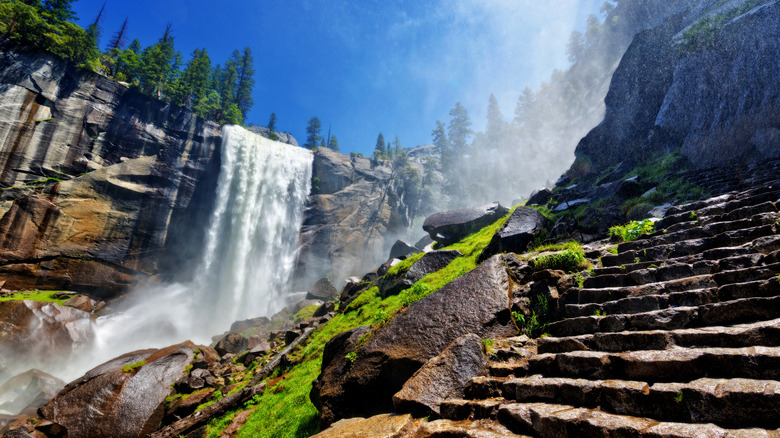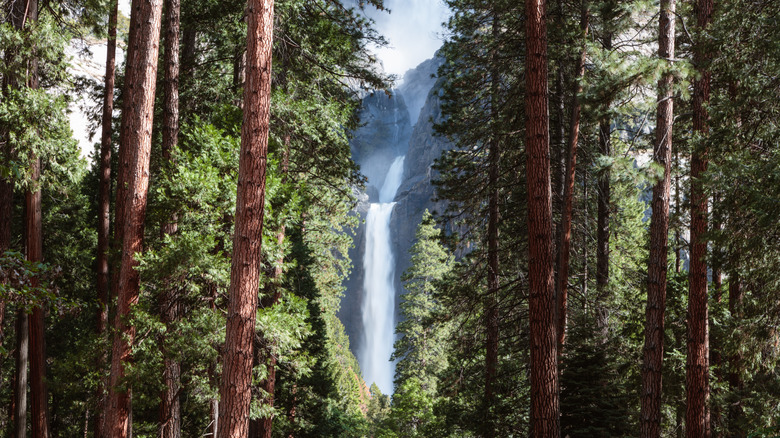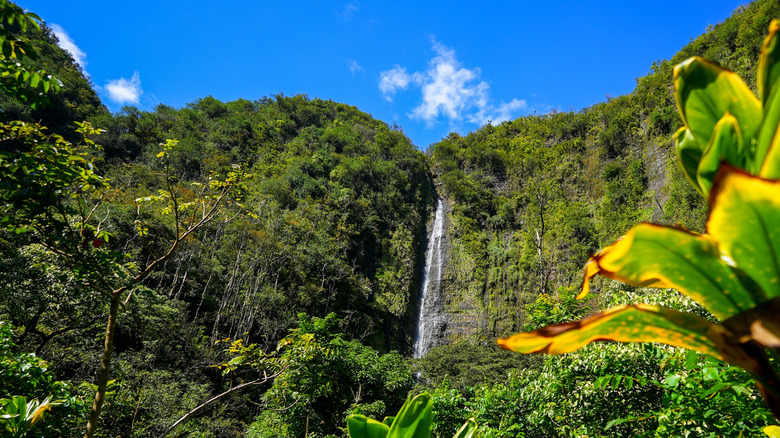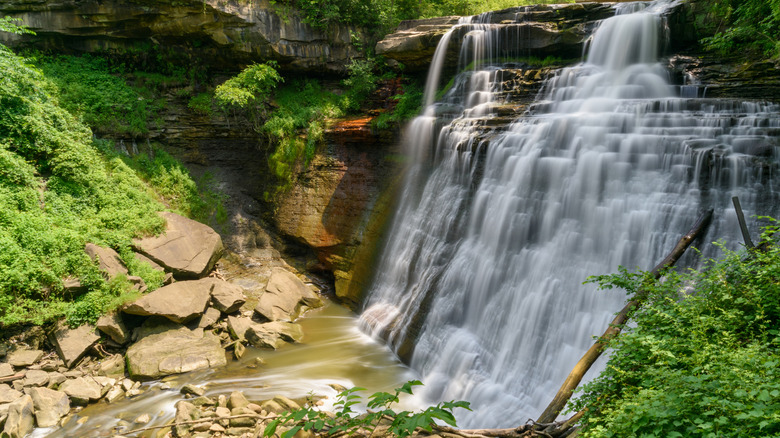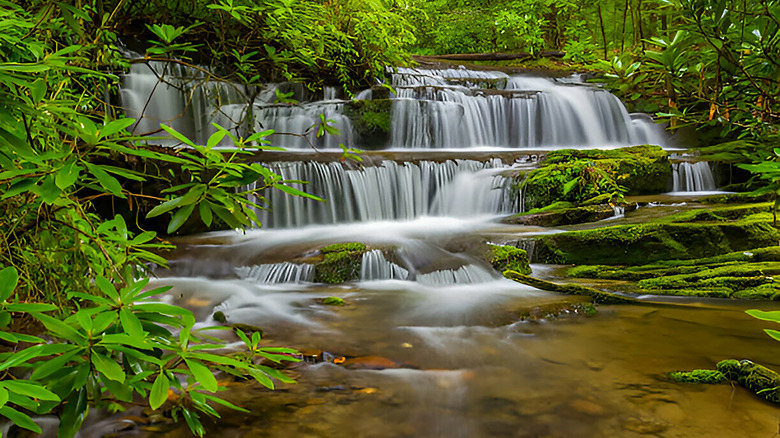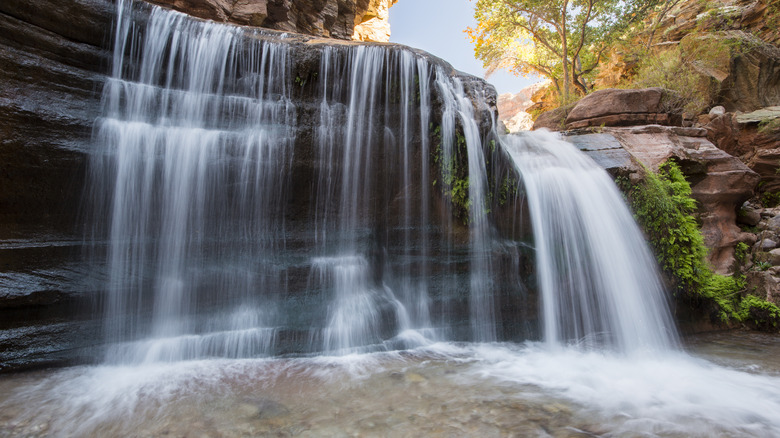Gorgeous US National Parks To Visit If You Love Waterfall Views
We may receive a commission on purchases made from links.
Waterfalls are stunning wonders to behold. These natural features occur on massive rivers and tiny streams. Some cascade hundreds of meters over mountains, while others fall gentle over boulders or carved crevasses. Some funnel to a narrow neck of water while others fan out over a great expanse. All told, there are more than 17,000 waterfalls scattered across the United States. A good many of these mesmerizing ecological elements are found within the boundaries of U.S. national parks.
Some of the parks which are home to spectacular waterfall views are among the more popular and are on almost everyone's national park bucket list. However, there are also some more obscure national parks dotting the country that contain some of America's most amazing waterfalls. Luckily for those who are fascinated by these watery cascades, there are parks in every section of the country that have waterfall features. So, anyone wanting to enjoy the ambiance created by falling water in a natural setting can to grab their hiking shoes, a waterproof adventure camera like the GoPro Hero 13, and head to numerous nearby parks. While the list of those parks is far too long for any one article, here are some gorgeous U.S. national parks to visit if you love waterfall views.
Yosemite National Park, CA
Drawing just under four million visitors a year, California's Yosemite National Park is one of the most popular national parks in America. It is also a menagerie of natural features and stunning landscapes. Glacial canyons, lofty peaks, massive granite formations such as El Capitan and Half Dome, and towering giant sequoias are just some of the natural features that leap out at visitors. However, it is the dizzying array of waterfalls within its 1,200 square miles for which Yosemite is best known.
There are so many falls within Yosemite that the actual number is unknown. However, close to a dozen falls found in Yosemite are among the highest in the U.S. The tallest, Yosemite Falls, drops more than 2,200 feet over a sheer mountain ledge. Among the other falls that cover a height over a thousand feet are Sentinel Falls, Ribbon Fall, Horsetail Fall, Wapama Falls, and Chilnualna Falls. Horsetail, which tumbles over the side of El Capitan, is not only famous for its thousand-foot fall, but also for its tendency to appear as a fiery glowing orange stream at sunset during the month of February.
While these amazing falls, along with the other natural features, may capture your gaze, be advised there are creatures to beware of when adventuring in Yosemite National Park. Additionally, although black bears are very common here, Yosemite is among the national parks that banned bear spray, so be sure to leave the bear mace behind if you are visiting Yosemite.
Haleakala National Park, HI
Located on the island of Maui, Hawaii's Haleakala National Park draws over a million visitors per year. Most of those who come to this Pacific Island park are drawn by the park's namesake crater, which rises some 10,000 feet above the Pacific Ocean. The hike to the top of this massive crater winds through a half dozen climate zones. Located near the summit is a high altitude observatory. However, although the park is renowned for its views of the stars and sky, it is the multiple points of falling water which adds ambiance to the stunning landscapes.
Waimoku Falls, which cascades some 400 feet down a sheer cliff covered with lush tropical vegetation is perhaps the best known of these falls. Makahiku Falls drops about half that distance, but bounds off several pieces of rock on the way down, giving it a very unique showering effect. Ohe'o Gulch, which is more commonly known as the Seven Sacred Pools, is a stair-stepped waterfall that is popular with visitors. Alelele Falls is much less known than the others, meaning it is the perfect location for a secluded waterfall hike.
Cuyahoga Valley National Park, OH
While Ohio may not be the place many people think of when envisioning cascading waterfalls, the Buckeye State's Cuyahoga Valley National Park is rated as one of the top waterfall viewing destinations in the United States. Additionally, Cuyahoga Valley is among the national parks that allow dogs on hiking trails, so you will be able to take your four-legged companion along as you trek to any of the more than 100 waterfalls located within the park.
According to AllTrails, among the top 10 waterfall hikes in Cuyahoga Valley National Park are several that either lead to or provide views of the park's most popular cascades, Brandywine Falls, which plummets some 65 feet over stair-stepped rocky ledges. Buttermilk Falls and Blue Hen Falls are two other popular waterfalls that are easily reached via hiking trails. Great Falls is among the easiest to reach, as it has a paved path that leads from the nearby parking lot. Other falls to put on your list while visiting Cuyahoga Valley National Park include Bridal Veil Falls, Mudcatcher Falls, Shredder Falls, and Hemlock Ravine Falls.
Great Smoky Mountain National Park, TN & NC
With more than 13 million visitors entering its boundaries each year, Great Smoky Mountains National Park draws the most visitors of any national park — by far. In fact, its annual attendance is triple that of the next closest national park. Although the park has numerous natural features and creatures to attract visitors, waterfalls are certainly one of the main draws for many park goers. In fact, hundreds of thousands of these visitors hike to the park's dozens of waterfalls, most of which are located in the northern half of the park. Many more drive to see some of the more popular cascades that form along the 2,000 miles of streams and rivers within Great Smoky Mountains National Park.
Among the more popular falls to hike to in Great Smoky Mountains National Park are Abrams Falls, Grotto Falls, Rainbow Falls, and Laurel Falls. Meigs Falls and The Sinks are two examples of falls that can be viewed from drive-up viewing locations. Meigs Falls is popular in winter as well, as it is known to freeze over in dramatic fashion during periods of severe cold weather. Place of a Thousand Drips is a very unique fall, as it branches out and splits countless times as it falls along a steep, rocky contour. Visitors can drive close to Place of a Thousand drips, then walk a short distance in order to view it.
Grand Canyon National Park, CO
Grand Canyon National Park is one of America's most iconic public places, as evidenced by the more than four million people who visit each year. This is due to the history and culture of the area, as well as the jaw-dropping natural features. While the steep-walled canyon itself is without a doubt the most dominant natural feature, contained within this massive canyon are numerous waterfalls that are among the more dramatic in the United States.
Although the Grand Canyon is in a desert, there is a surprising amount of water found here. The Colorado River has carved the canyon and the portion of the river that lies within the park drains more than 40,000 acres. Nearly two dozen streams connect to the river within Grand Canyon National Park. Along the route of the river and connecting streams are numerous waterfalls of various sizes. Deer Creek Falls, Elves Chasm, Ribbon Falls, Cheyava Falls, and Thunder River are among the more impressive falls found within Grand Canyon National Park.
It is important to note the most famous cascade in the Grand Canyon, Havasu Falls, is not located inside the national park. It lies on the adjacent Havasupai Reservation. Anyone wishing to make the 10-mile hike to Havasu Falls will need a permit from the reservation to access the trail and falls.
